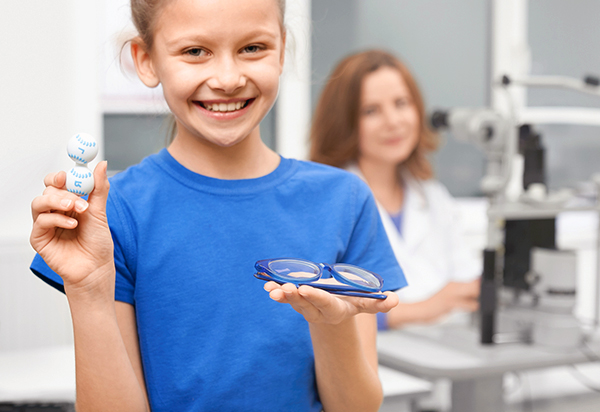Contacts 101
Considering contact lenses for the first time or trying a new type of lens? Here’s what to expect:
- Schedule a contact lens appointment. Your optometrist will exam your eyes and confirm you’re a good candidate for contact lenses. They’ll recommend a contact lens that matches your eyes’ unique features to maximize your comfort, vision and lifestyle.
-
Next you’ll be fitted for contacts and be taught how to insert, remove and care for your contact lenses. You’ll be given a trial pair to wear.
Since contact lenses are fit individually to each person, follow-up appointments are needed to ensure optimal comfort and vision. For most people this takes 1-2 visits that are covered by a special fitting fee (see below).

- A check-back visit will be scheduled within 1-2 weeks. During the fitting process, your optometrist may decide a different lens would work better for you. Any lens changes or follow-up visits are covered under the contact lens evaluation period—120 days from your initial exam.
- Once the contact lenses have been confirmed as a good fit, your optometrist will finalize your contact lens prescription (which is separate from your eyeglass prescription). You can purchase your contact lenses at an optical shop and enjoy clear vision!
When you need refills, you can setup an account to reorder them online and get free shipping or reorder by phone.
Future contact lens exams should be scheduled every 1-2 years depending on the recommendation of your eye doctor.
- Your copay, if you have one, covers your general eye health exam and refraction (eyeglass prescription).
- An additional $60 fee is associated with a contact lens evaluation.* This fee covers your fitting, trial lenses, insertion and removal training, and follow-up visits for 120 days.
- The cost of lenses is separate but may be covered by your optical benefits, if available.
*Specialty lens fits such as scleral and hybrid lenses, have a fitting evaluation of $395. Evaluation fees subject to change without notice.
Nervous? Don’t be. Putting contact lenses on and taking them off is easier than you might think.
Watch this quick video tutorial on how to safely put on your contact lenses.
Watch this quick video tutorial on how to safely take off your contact lenses.
Scleral Lenses: Insertion, Removal and Troubleshooting
Video provided by the Scleral Lens Education Society.
Here are some basic tips for proper care and successful wearing of your contacts.
- Wash your hands with soap and water and dry them with lint-free towel before handling lenses.
- Always apply and remove the same side first to avoid switching the lenses.
- Rub your lenses for at least 10 seconds on each side immediately after removal—rubbing helps remove deposits.
- Keep the contact lens case clean and replace every 3 months.
- Keep a backup pair of useable glasses in case you can’t wear your lenses.
- Remove your lenses before swimming or bathing.
- Put your contacts on before applying makeup. Remove lenses first, then remove makeup.
- Wear and replace lenses according to the schedule prescribed by the doctor.
- Mix solutions—use only the specified sterile solutions commercially prepared for contact lenses.
- Reuse solution—change and replace with fresh solution every day.
- Use tap water or distilled water for rinsing or storing soft lenses.
- Use saliva to wet your lenses.
- Rub your eyes.
- Wear lenses longer than the prescribed wearing time.
- Sleep with your lenses inserted unless specified by your doctor to do so.
- Wear lenses when eyes are red, irritated, or painful, or when vision is blurred.
- Wear contact lenses if you feel ill; switch to glasses until you feel better.
Learn more about contact lens care, including how to remove a contact lens that’s stuck.
Your eye doctor will help you decide which type of lens is best for you.
- Spherical: Have the same lens power throughout the entire contact lens to correct myopia (nearsightedness) or hyperopia (farsightedness).
- Toric: Correct vision for people with astigmatism.
- Multifocal: Generally has two prescriptions (or ‘powers’) in the same lens to correct near vision and distance vision. Multifocal contacts also can correct astigmatism.
-
Soft:
Made of soft, flexible plastics that allow oxygen to pass through to the
cornea. Soft contact lenses are comfortable and easy to adjust to. Soft lenses
tend to be more stable making them ideal for active lifestyles.
— Silicone hydrogels: An advanced type of soft contact lens material that allows more oxygen to reach the cornea.
- Gas-permeable (GP): Rigid lenses that allow oxygen to reach the eye. Designed for increased durability and better focus.
- Myopia management: For children 8 to 12 that may help slow the progression of nearsightedness, or myopia.
- Specialty: Custom designed lenses for certain eye conditions.
Kids and teens can wear contacts successfully. Our eye doctors offer several approaches to manage myopia (nearsightedness) using contact lenses:
- MiSight®1 day soft contact lenses are FDA-approved lenses designed to slow the progression of myopia in children 8-12 years of age at initiation of treatment. The contacts are changed daily, so no cleaning needed. Learn more about myopia management with MiSight®1 day lenses here.
- Corneal Refractive Therapy (CRT)— also known as orthokeratology—utilizes rigid contact lenses worn overnight to gently reshape the cornea (front of the eye) during sleep. The result is good daytime vision without the use of contacts or eyeglasses. It’s ideal for reducing the progression of myopia and dependence on glasses in kids (starting around 8 years old) and young adults. Learn about CRT here.
- Multifocal soft contact lenses worn daily can help stabilize the eye and reduce progression of myopia by in most patients. Ideal because they’re widely available and can be used by most nearsighted patients.

- Atropine eye drops are low concentration prescription drops instilled nightly. They relax the eyes’ focusing mechanisms which has been found to help reduce the progression of nearsightedness in children. They are sometimes used along with contact lenses.
- Keep up on eye exams and prescriptions. It’s recommended that kids with myopia get an eye exam every 12 months. Kids’ eyesight does not stabilize until age 22. If kids are wearing outdated glasses or contact lenses and are not fully corrected, then myopia can increase significantly.
- Spend time outside. Studies suggest that spending 2-3 hours outside during the daytime exposed to bright sunlight can help slow myopia progression in kids. Indoor lighting is only about 10% of the brightness of a sunny day.

Talk about myopia treatment options with your Kaiser Permanente eye doctor to see if your child qualifies. Schedule an exam.
References:
1. Chamberlain P, et al. A 3-year randomized clinical trial of MiSight® lenses for myopia control.
Optom Vis Sci. 2019;96(8):556-557.
